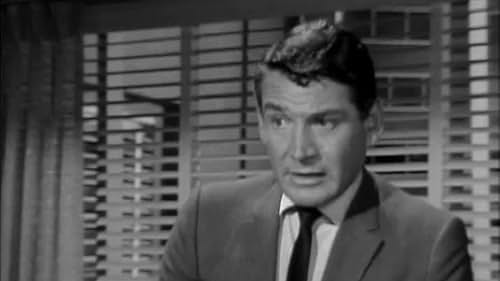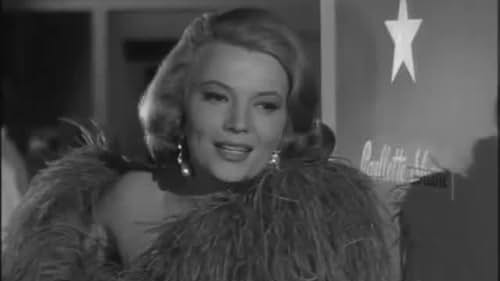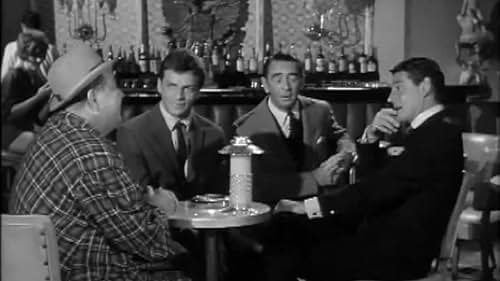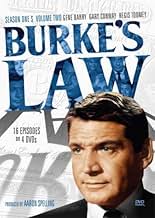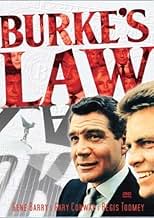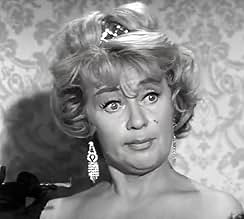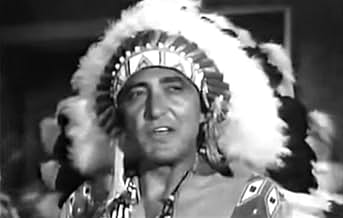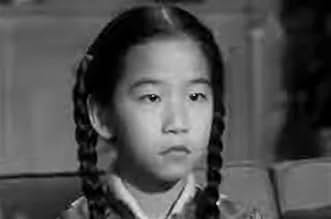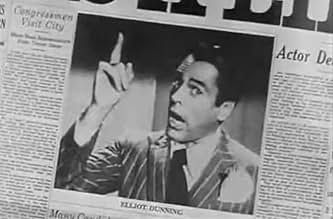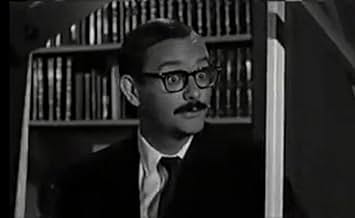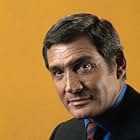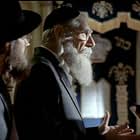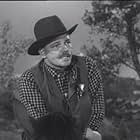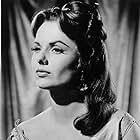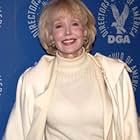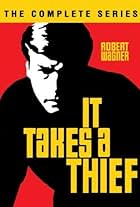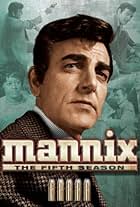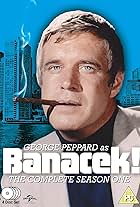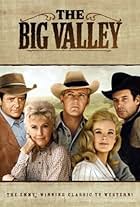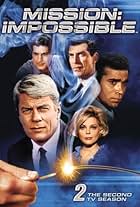The millionaire captain of the LAPD homicide division is driven to the crime scenes in his 1962 Rolls-Royce by his loyal chauffeur.The millionaire captain of the LAPD homicide division is driven to the crime scenes in his 1962 Rolls-Royce by his loyal chauffeur.The millionaire captain of the LAPD homicide division is driven to the crime scenes in his 1962 Rolls-Royce by his loyal chauffeur.
- Awards
- 1 win & 2 nominations total
Browse episodes
Storyline
Did you know
- TriviaFor the show's final season in 1965 - 66, the format was completely changed in order to capitalize on the popularity of spy shows like "The Man from U.N.C.L.E. (1964)," with Amos Burke himself becaming a secret agent. The title of the series was changed accordingly: "Amos Burke - Secret Agent." But the new format proved unpopular, and the show was cancelled.
- Crazy creditsIn the opening credits, the title of the show was always announced by the voice of a woman saying, VERY seductively, "Burke's Law".
- Alternate versionsSome "Amos Burke, Secret Agent" syndication prints retain that title sequence, but with the title changed to "Burke's Law" and a male announcer speaking the title (as with the original "Amos Burke, Secret Agent" episodes).
- ConnectionsFollowed by Burke's Law (1994)
Featured review
I would love to run across the "Archive of Television" interview series that explains just what they were thinking when the eventually legendary Aaron Spelling and company put this together for the fall, 1963, television season. It had been back-door piloted two years earlier in the DICK POWELL THEATER anthology series, but Powell was a 1950's noire tough-guy actor while this series presented the most suave, debonair actor on weekly television, Gene Barry. The thinking seems to have been to take the venerable fantasy of the "whodunnit" and modernize it in the most smart, up-to-date style with generous helpings of contemporary American TV wit surmounted by gobs of Camelot-era glitz and glam.
Not only were the likes of doughty Miss Jane Marple or fussy Hercule Poirot updated to a smooth, handsome lady-killer in a perpetual tuxedo who was designed to make James Bond envious, but the protagonist police detective was the heir to a fortune of at least seven million dollars (probably more like 70 in today's money) and except for his job, fully lived the dream, complete with Hollywood mansion, extravagant chauffeur-driven luxury sedan, and what might be the largest (or at least one of the most appealing) retinue of sex-starved babes in the history of television. And although in the better episodes they did manage to hit some of the better heights of weekly television drama, mostly the emphasis was pretty lightweight, focusing in perhaps equal parts on light humor and action.
With that much to contemplate the reviewer knows scarcely where to begin. Under the circumstances, then, maybe it would be best to begin at the beginning. I first saw this show at about age 11, and I can't remember now just what all appealed to me about it so strongly then, except for one thing: the most curvaceous, most gorgeous thing I'd ever seen in one whole decade of living, and of course I'm referring to Burke's Rolls-Royce Silver Cloud sedan. This car was practically a character in the show. Probably never in the history of television has an automobile been so strongly emphasized - not even Don Johnson's or Tom Selleck's Ferraris; not even, of all things, the Batmobile (the only exception that comes to mind would be shows where the car explicitly was a character, such as in Knight Rider or My Mother The Car - but I digress). Shot after shot was set up to emphasize it. It even had its own theme music (which was the big, bold, brassy jazz theme song of the show itself, and nothing could have been better - surely, the composer was looking at footage of the car doing its thing as he worked).
The idea seems to have been not only to continuously rub the protagonist's sumptuous fantasy lifestyle into the viewers' eyeballs, but in fact the car actually functioned as the unifying element in the plot development of the episodes. While in the traditional whodunnit the various suspect characters are typically united by geography - e.g., they are all together in an English country house during a gale, or on a Nile River excursion steamer, or the fabled Orient Express passenger train caught snowbound in the Balkans outback - here, in the car-crazy culture of early 1960's Southern California, it is this regal motor vehicle which takes the detective to the crime scene and then back and forth among the characters as he puts the pieces together to solve the case, often finding cause to interview them while riding inside of it (especially if they are female and under 35; on one occasion, when guest-star Elsa Lanchester didn't quite fit that formula, the interview occurred afoot during a stroll down a country road with the car following prominently behind in full view for several minutes' screen time). Councils of war among the hero and his staff are regularly held within it; and moreover every episode's opening credits begin with Amos Burke and his Filipino man-servant, Henry, rushing in classic action-hero form to the car while the rousing, booming, boisterous opening notes of the theme crank up in perfect synchronization to the car's emergence from the driveway, and every show's ending credits roll with a shot of it parked once again back in the circular drive in front of Burke's mansion, dutifully awaiting its next foray into the world of criminal detection.
And that leads us to the part I could not appreciate quite so well at 11 as I could later. As one might have guessed by now, the pre-credits teaser of every show naturally features our hero right smack in the middle of romancing some comely female, only to be interrupted by the obligatory dreaded telephone call summoning him to yet another inevitable crime scene. This was one of these shows where a large cast of name-brand guest stars was required every week, and the litany of the actors who appeared would probably look like an early-1960's Hollywood telephone book. In particular, probably never was any show so heavily populated with young television starlets (generally on their way up) which makes this a delight to watch as no amount of Connolly leather upholstery and sheet metal under thirty coats of hand-polished paintjob ever could. A partial list (simply from memory) includes such luminaries as Elizabeth Montgomery (can you imagine her playing high on Absinthe?), Barbara Eden, Lola Albright, Nancy Kovack, Zza Zza Gabor, Eva Gabor, Annette Funicello, Anne Francis, Debra Paget, Suzy Parker, Antoinette Bower, Glynis Johns, Jill Haworth, Nancy Sinatra, Dana Wynter, Dawn Wells, Tina Louise, Dina Merrill, Carolyn Jones, Jill St. John, Jayne Mansfield . . . And if somebody a little more grown up is to your taste, there was also Ida Lupino, Gloria Grahame, June Allyson, Ruth Roman, and even Vera Miles, Mary Astor, Dorothy Lamour, and Gloria Swanson . . . (and I imagine a female reviewer enthused with the period could come up with a list of male guest stars that would amply complement this list; certainly it bulged with well-known comedians and character actors). Probably the only things missing were Linda Evans, Sally Field, and Mary Tyler Moore (but they did manage a cameo of David Niven, of all people).
If this show had any fault it may have been that it was trying to do so many things at the same time that it couldn't expect to do all of hem consistently well every week, and sometimes the dialog just didn't pay off. Moreover, a good bit of true talent was wasted. At times Barry showed hints of a lot of talent that was barely tapped but which would have markedly enriched the show had it been, while veteran co-stars like Regis Toomey and Leon Lontoc were usually badly under-exploited. Lontoc in particular was a very funny natural comic and when actually given something to do never failed to entertain, and it is disappointing that more was not made of the sort of Rochester/Benny relationship his character, Henry the man-Friday, had with Barry's Burke. One supporting actor who was not underused was Gary Conway as the boy-wonder apprentice detective, Tim Tillson, the youthful prodigy who had everything but rank and experience. This also meant that, in order to know every conceivable useful fact in a case and never miss a single trick in checking out leads, and in direct opposition to his own leading-man good looks, he was what nowadays we would call a geek or a nerd, something he pulled off with aplomb (I especially like the time he was grossly disappointed he could not get the evening off because it was the night the grunion were running - true story).
In sum, Burke's Law can be relied upon to offer an always entertaining look back at Kennedy-era cool.
Not only were the likes of doughty Miss Jane Marple or fussy Hercule Poirot updated to a smooth, handsome lady-killer in a perpetual tuxedo who was designed to make James Bond envious, but the protagonist police detective was the heir to a fortune of at least seven million dollars (probably more like 70 in today's money) and except for his job, fully lived the dream, complete with Hollywood mansion, extravagant chauffeur-driven luxury sedan, and what might be the largest (or at least one of the most appealing) retinue of sex-starved babes in the history of television. And although in the better episodes they did manage to hit some of the better heights of weekly television drama, mostly the emphasis was pretty lightweight, focusing in perhaps equal parts on light humor and action.
With that much to contemplate the reviewer knows scarcely where to begin. Under the circumstances, then, maybe it would be best to begin at the beginning. I first saw this show at about age 11, and I can't remember now just what all appealed to me about it so strongly then, except for one thing: the most curvaceous, most gorgeous thing I'd ever seen in one whole decade of living, and of course I'm referring to Burke's Rolls-Royce Silver Cloud sedan. This car was practically a character in the show. Probably never in the history of television has an automobile been so strongly emphasized - not even Don Johnson's or Tom Selleck's Ferraris; not even, of all things, the Batmobile (the only exception that comes to mind would be shows where the car explicitly was a character, such as in Knight Rider or My Mother The Car - but I digress). Shot after shot was set up to emphasize it. It even had its own theme music (which was the big, bold, brassy jazz theme song of the show itself, and nothing could have been better - surely, the composer was looking at footage of the car doing its thing as he worked).
The idea seems to have been not only to continuously rub the protagonist's sumptuous fantasy lifestyle into the viewers' eyeballs, but in fact the car actually functioned as the unifying element in the plot development of the episodes. While in the traditional whodunnit the various suspect characters are typically united by geography - e.g., they are all together in an English country house during a gale, or on a Nile River excursion steamer, or the fabled Orient Express passenger train caught snowbound in the Balkans outback - here, in the car-crazy culture of early 1960's Southern California, it is this regal motor vehicle which takes the detective to the crime scene and then back and forth among the characters as he puts the pieces together to solve the case, often finding cause to interview them while riding inside of it (especially if they are female and under 35; on one occasion, when guest-star Elsa Lanchester didn't quite fit that formula, the interview occurred afoot during a stroll down a country road with the car following prominently behind in full view for several minutes' screen time). Councils of war among the hero and his staff are regularly held within it; and moreover every episode's opening credits begin with Amos Burke and his Filipino man-servant, Henry, rushing in classic action-hero form to the car while the rousing, booming, boisterous opening notes of the theme crank up in perfect synchronization to the car's emergence from the driveway, and every show's ending credits roll with a shot of it parked once again back in the circular drive in front of Burke's mansion, dutifully awaiting its next foray into the world of criminal detection.
And that leads us to the part I could not appreciate quite so well at 11 as I could later. As one might have guessed by now, the pre-credits teaser of every show naturally features our hero right smack in the middle of romancing some comely female, only to be interrupted by the obligatory dreaded telephone call summoning him to yet another inevitable crime scene. This was one of these shows where a large cast of name-brand guest stars was required every week, and the litany of the actors who appeared would probably look like an early-1960's Hollywood telephone book. In particular, probably never was any show so heavily populated with young television starlets (generally on their way up) which makes this a delight to watch as no amount of Connolly leather upholstery and sheet metal under thirty coats of hand-polished paintjob ever could. A partial list (simply from memory) includes such luminaries as Elizabeth Montgomery (can you imagine her playing high on Absinthe?), Barbara Eden, Lola Albright, Nancy Kovack, Zza Zza Gabor, Eva Gabor, Annette Funicello, Anne Francis, Debra Paget, Suzy Parker, Antoinette Bower, Glynis Johns, Jill Haworth, Nancy Sinatra, Dana Wynter, Dawn Wells, Tina Louise, Dina Merrill, Carolyn Jones, Jill St. John, Jayne Mansfield . . . And if somebody a little more grown up is to your taste, there was also Ida Lupino, Gloria Grahame, June Allyson, Ruth Roman, and even Vera Miles, Mary Astor, Dorothy Lamour, and Gloria Swanson . . . (and I imagine a female reviewer enthused with the period could come up with a list of male guest stars that would amply complement this list; certainly it bulged with well-known comedians and character actors). Probably the only things missing were Linda Evans, Sally Field, and Mary Tyler Moore (but they did manage a cameo of David Niven, of all people).
If this show had any fault it may have been that it was trying to do so many things at the same time that it couldn't expect to do all of hem consistently well every week, and sometimes the dialog just didn't pay off. Moreover, a good bit of true talent was wasted. At times Barry showed hints of a lot of talent that was barely tapped but which would have markedly enriched the show had it been, while veteran co-stars like Regis Toomey and Leon Lontoc were usually badly under-exploited. Lontoc in particular was a very funny natural comic and when actually given something to do never failed to entertain, and it is disappointing that more was not made of the sort of Rochester/Benny relationship his character, Henry the man-Friday, had with Barry's Burke. One supporting actor who was not underused was Gary Conway as the boy-wonder apprentice detective, Tim Tillson, the youthful prodigy who had everything but rank and experience. This also meant that, in order to know every conceivable useful fact in a case and never miss a single trick in checking out leads, and in direct opposition to his own leading-man good looks, he was what nowadays we would call a geek or a nerd, something he pulled off with aplomb (I especially like the time he was grossly disappointed he could not get the evening off because it was the night the grunion were running - true story).
In sum, Burke's Law can be relied upon to offer an always entertaining look back at Kennedy-era cool.
- How many seasons does Burke's Law have?Powered by Alexa
Details
- Release date
- Country of origin
- Language
- Also known as
- Amos Burke, Secret Agent
- Filming locations
- 3755 Longridge Ave, Sherman Oaks, Los Angeles, California, USA(Burke's mansion)
- Production companies
- See more company credits at IMDbPro
- Runtime50 minutes
- Color
- Aspect ratio
- 1.33 : 1
Contribute to this page
Suggest an edit or add missing content


